Blackjack: An Ace or Ten in the Hand
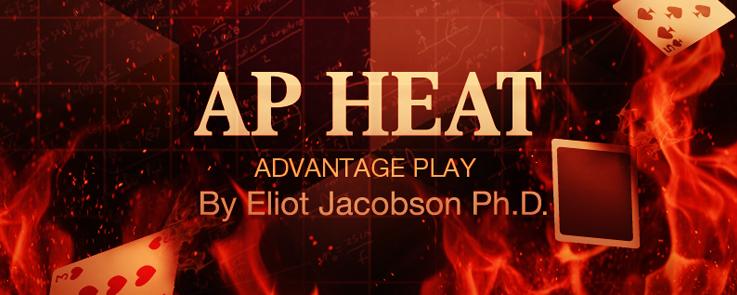
By Anonymous
|
|
Casinos around the world are getting hit by advantage play teams involved in various schemes that allow them to predict when Aces and ten-valued cards are likely to be dealt. When I searched the literature for the edges possible from this type of play, I was surprised to find that these numbers are not publicly available. This post corrects this deficit in the literature by giving the player edge when an Ace/Ten is a known card in a hand. This post also summarizes the most common techniques that advantage players use to obtain this information, as well as giving game protection suggestions. I finish this post with references for further study.
The table below uses the following abbreviations:
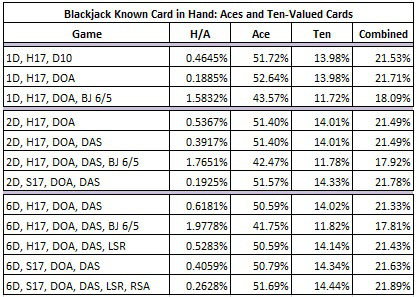
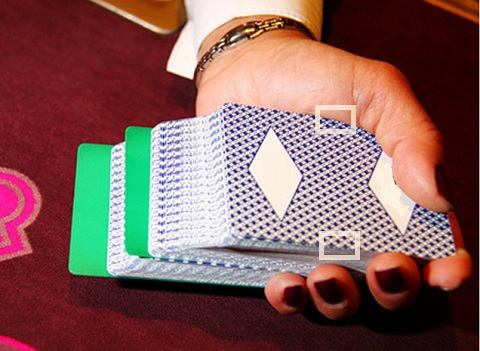
In addition to first-card knowledge, edge sorting also allows players to make more accurate hit/stand/double/insurance decisions during the round.
Edge sorting can look like card marking. One table games director lamented to me that, “a team has been marking the cards against us for the last two months, but when we examine the cards we can’t see their marks.” When I asked him to show me his cards and his shuffle procedure, it took just a moment for him to realize that the cards were marked, but not by the players.
The defense to edge sorting is to include a turn in every shuffle. That includes proprietary games that use an automatic shuffler and shoe games where the player doesn’t touch the cards. Use a turn in every shuffle!
First Card Exposure
Some dealers expose the corner of a card as they are waiting for players to place their wagers for the next round. Dealers with nervous or fidgety hands often shift the deck around as they hold the cards. An exposed index may look something like the following:
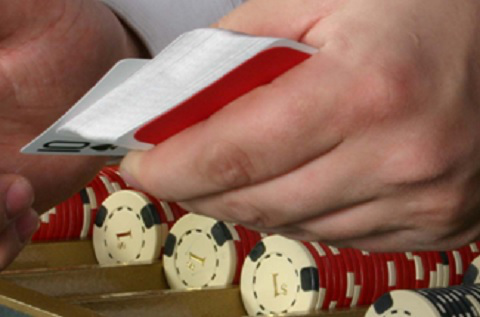
This type of exposure sometimes takes place at the start of the round. It can also take place mid-round, at which point the player may know the dealer’s hole-card, or he may be able to know the next card he would receive if he took a hit or doubled. On seeing that the first card to be dealt the next round is a premium card (an Ace/Ten), the AP gets his edge.
Consider the following example. Assume an AP is playing a heads-up game against a sloppy dealer. Suppose the dealer has a Ten as his up card. Next, suppose the player is holding the cards 4/3 for a total of 7. His correct play is, obviously, to hit. But, assume he sees the corner of the card (as in the picture above) is the Ten of Spades. He then stands on his hard 7. That way he preserves the valuable Ten as his first card for the next round. When the next round comes, if the dealer didn’t take a hit, the AP makes a large wager knowing he will get that Ten as his first card. Depending on the blackjack rules at the table, the AP may have more than a 14% edge over the house on that hand.
The defense to first card exposure is proper dealer training, together with frequent audits of the dealers.
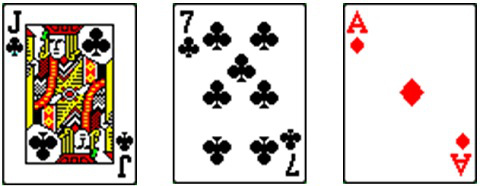
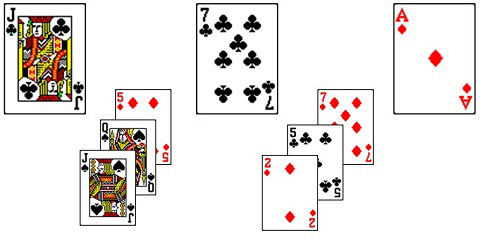
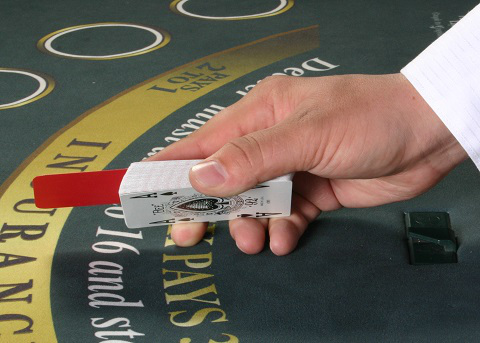
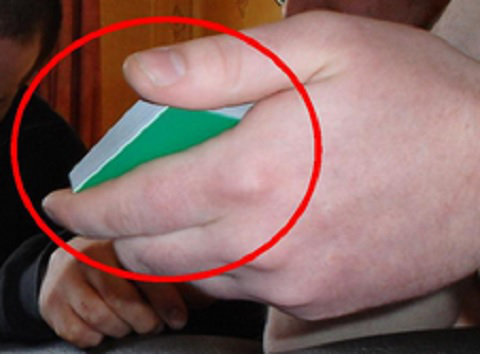
Another possibility is for the house to always perform the cut. Players often object to a dealer cut, believing it to be bad luck.
Game Protection
Ace/Ten location play is big-time. It is being used today, somewhere, to demolish a poorly protected game. To defend your blackjack games from location play:
Further Study
I highly recommend watching the following YouTube videos, by esteemed game protection experts Bill Zender and Willy Allison: https://www.youtube.com/watch?v=5jnntu56kSo https://www.youtube.com/watch?v=3W1MlolKAvg
The following articles also provide excellent information:
The table below uses the following abbreviations:
- BJ 6/5, blackjack pays 6-to-5. Otherwise, blackjack pays 3-to-2.
- H17, dealer must hit on soft-17.
- S17, dealer must stand on soft-17.
- D10, player can double down on hard 10, 11 only.
- DOA, player can double down on any two cards.
- DAS, player can double down after a split.
- LSR, player can surrender. If the dealer’s up-card is an Ace or ten-valued, the player must wait until after the dealer checks for blackjack.
- RSA, player can re-split Aces.

Note that BJ 6/5 reduces the edge for an Ace by about 10%, the value of the Ten is reduced by just over 2% and the combined edge is reduced by about 4%. On the other hand, games where blackjack pays 6-to-5 are often not taken seriously with respect to their game protection issues. Weak and inexperienced dealers and poor procedures often accompany 6/5 games. Advantage players know that 6/5 games are a rich source of opportunities.
In the advantage play universe, there are very few opportunities where edges in excess of 50% are possible (hole-carding Mississippi Stud is one of them). Methods that allow Aces or Tens to be predicted are extraordinarily valuable to the AP. In some cases, these methods are opportunistic: an unskilled dealer or dirty cards. More often, an AP team works together to create the circumstances that yield this valuable information.
The following summarizes some of the ways that advantage players obtain and exploit Ace/Ten information.
Edge Sorting
Edge sorting blackjack is one of the oldest and most reliable ways for an AP team to get a big edge. The team works together to sort the deck by the groups: {2, 3, 4, 5, 6, 7, 8, 9} and {T, J, Q, K, A}. This sort most likely takes place in a single or double-deck hand-held game. The player seated at first base reads the top card at the start of each round. If the first card to be dealt is an Ace/Ten, he wagers large.
The following picture illustrates how this may look at the table:
The following summarizes some of the ways that advantage players obtain and exploit Ace/Ten information.
Edge Sorting
Edge sorting blackjack is one of the oldest and most reliable ways for an AP team to get a big edge. The team works together to sort the deck by the groups: {2, 3, 4, 5, 6, 7, 8, 9} and {T, J, Q, K, A}. This sort most likely takes place in a single or double-deck hand-held game. The player seated at first base reads the top card at the start of each round. If the first card to be dealt is an Ace/Ten, he wagers large.
The following picture illustrates how this may look at the table:

In addition to first-card knowledge, edge sorting also allows players to make more accurate hit/stand/double/insurance decisions during the round.
Edge sorting can look like card marking. One table games director lamented to me that, “a team has been marking the cards against us for the last two months, but when we examine the cards we can’t see their marks.” When I asked him to show me his cards and his shuffle procedure, it took just a moment for him to realize that the cards were marked, but not by the players.
The defense to edge sorting is to include a turn in every shuffle. That includes proprietary games that use an automatic shuffler and shoe games where the player doesn’t touch the cards. Use a turn in every shuffle!
First Card Exposure
Some dealers expose the corner of a card as they are waiting for players to place their wagers for the next round. Dealers with nervous or fidgety hands often shift the deck around as they hold the cards. An exposed index may look something like the following:

This type of exposure sometimes takes place at the start of the round. It can also take place mid-round, at which point the player may know the dealer’s hole-card, or he may be able to know the next card he would receive if he took a hit or doubled. On seeing that the first card to be dealt the next round is a premium card (an Ace/Ten), the AP gets his edge.
Consider the following example. Assume an AP is playing a heads-up game against a sloppy dealer. Suppose the dealer has a Ten as his up card. Next, suppose the player is holding the cards 4/3 for a total of 7. His correct play is, obviously, to hit. But, assume he sees the corner of the card (as in the picture above) is the Ten of Spades. He then stands on his hard 7. That way he preserves the valuable Ten as his first card for the next round. When the next round comes, if the dealer didn’t take a hit, the AP makes a large wager knowing he will get that Ten as his first card. Depending on the blackjack rules at the table, the AP may have more than a 14% edge over the house on that hand.
The defense to first card exposure is proper dealer training, together with frequent audits of the dealers.
Incidental Card Exposure
I was card counting a six-deck game when the dealer accidentally took an extra hit to her hand. She had a multi-card hard 17 and simply miscounted, drawing the extra card. She exposed a Ten to the table. After an appeal to the pit staff to not “ruin the flow” of the shoe, it was decided that the Ten would become the first card of the next round, dealt to first base. Too bad I wasn’t seated there.
Incidental card exposure occurs all the time. Just like the incident described above, it is frequently the case that the exposed card is not burned. The casino faces extreme financial risk if the exposed card is an Ace or Ten and they choose to deal that card the next round.
The defense to incidental card exposure is to always burn every improperly exposed card.
Incidental Card Marking
Marking cards is illegal and is not advantage play. Ways to illegally mark cards includes bends, scratches, cuts, chip-presses and the use of daub. However, for the astute advantage player, cards sometimes get incidental marks during the normal course of play. If an Ace or Ten gets such a mark, this information can legally be used against the house.
I was card counting single deck at a casino in Laughlin, Nevada (oh, so long ago). The cards were grossly over-used, with dirt and smudges covering them front and back. It was so disgusting that I naively requested a fresh deck be brought to the table. The pit declined, saying that the cards would not be replaced for another two hours.
A few weeks ago I was visiting a casino and paused to observe their shoe game. The cards appeared well-used and obviously in need of replacement. I asked when fresh cards would be brought in. I was told that the cards were replaced every two days. Sooner or later the cost of their card-replacement procedure is going to cost a lot more than the cost of a few decks of cards.
The defense to incidental card marking is to change cards frequently and to have the dealer always be on guard for broken, bent or dirty cards.
Sequencing
Sequencing is used to estimate when an Ace is likely to be dealt and to force that Ace to one of the player’s hands. The trick is to track key-cards, the cards that were placed on top of the Ace in the discard tray on the previous shoe. This method is best suited for a six-deck or eight-deck shoe game with a weak shuffle procedure.
For example, assume that the Ace of Diamonds (AD) is placed into the discard tray with the 7C and JC placed immediately on top of it:
Incidental card exposure occurs all the time. Just like the incident described above, it is frequently the case that the exposed card is not burned. The casino faces extreme financial risk if the exposed card is an Ace or Ten and they choose to deal that card the next round.
The defense to incidental card exposure is to always burn every improperly exposed card.
Incidental Card Marking
Marking cards is illegal and is not advantage play. Ways to illegally mark cards includes bends, scratches, cuts, chip-presses and the use of daub. However, for the astute advantage player, cards sometimes get incidental marks during the normal course of play. If an Ace or Ten gets such a mark, this information can legally be used against the house.
I was card counting single deck at a casino in Laughlin, Nevada (oh, so long ago). The cards were grossly over-used, with dirt and smudges covering them front and back. It was so disgusting that I naively requested a fresh deck be brought to the table. The pit declined, saying that the cards would not be replaced for another two hours.
A few weeks ago I was visiting a casino and paused to observe their shoe game. The cards appeared well-used and obviously in need of replacement. I asked when fresh cards would be brought in. I was told that the cards were replaced every two days. Sooner or later the cost of their card-replacement procedure is going to cost a lot more than the cost of a few decks of cards.
The defense to incidental card marking is to change cards frequently and to have the dealer always be on guard for broken, bent or dirty cards.
Sequencing
Sequencing is used to estimate when an Ace is likely to be dealt and to force that Ace to one of the player’s hands. The trick is to track key-cards, the cards that were placed on top of the Ace in the discard tray on the previous shoe. This method is best suited for a six-deck or eight-deck shoe game with a weak shuffle procedure.
For example, assume that the Ace of Diamonds (AD) is placed into the discard tray with the 7C and JC placed immediately on top of it:

If the shuffle procedure involves two riffles (and the riffles are done perfectly), then exactly three cards will be placed in the gaps between these cards. After the shuffle, this sequence may look something like:

The sequencing team follows the key cards through the shuffle so that they have a rough idea when the cards are likely to come out. On seeing the JC, they can estimate about 7 cards until the Ace. On seeing the 7C, the Ace is due in after about 3 more cards.
Once the key cards appear, the critical moment comes for the team. They must steer the Ace to one of the players on the team and away from the dealer. This can be done by selectively choosing to hit/stand/split in violation of basic strategy. The team will most likely position themselves so that their big player is occupying the middle two seats. The big player wagers near table maximum, while the players at first and third base each wager near table minimum. The players attempt to steer the Ace to the middle player, while using the other four spots, if needed, as blockers to keep the key card from the dealer’s hand.
The vital part of the shuffle procedure that helps guard against sequencing is the “strip.” Unfortunately, many casinos do not understand the purpose of the strip and either omit it or place it first in their shuffle procedure. If the strip comes before any riffles, then there are no additional cards placed between the key cards and Ace. In this case, it is highly unlikely that a strip will separate the Ace from its key cards.
A strip is only useful if it breaks up sequences. A strip has almost no game-protection value when it occurs before the riffles. The best place for a strip is after two riffles. The strip, like the turn, should come late in the shuffle procedure. In other words, for single or double-deck, Riffle-Riffle-Strip-Turn-Riffle-Cut.
Skilled Cutting
If the bottom card is exposed in a single or double-deck game, then a skilled cutter can cut that card to a specific position in the next round. When I say “skilled,” I mean, if you practice for 15 minutes you can do it too. Try it. Take out a deck of cards and put the Ace of Spades on bottom. Now practice placing the cut card 12 cards from the bottom. In a matter of minutes you will be able to accomplish the feat with nearly 100% accuracy. You will then know that the Ace of Spades will be the 12-th card dealt (including the burn card) in the next round.
The following picture illustrates the cutters dream situation:
Once the key cards appear, the critical moment comes for the team. They must steer the Ace to one of the players on the team and away from the dealer. This can be done by selectively choosing to hit/stand/split in violation of basic strategy. The team will most likely position themselves so that their big player is occupying the middle two seats. The big player wagers near table maximum, while the players at first and third base each wager near table minimum. The players attempt to steer the Ace to the middle player, while using the other four spots, if needed, as blockers to keep the key card from the dealer’s hand.
The vital part of the shuffle procedure that helps guard against sequencing is the “strip.” Unfortunately, many casinos do not understand the purpose of the strip and either omit it or place it first in their shuffle procedure. If the strip comes before any riffles, then there are no additional cards placed between the key cards and Ace. In this case, it is highly unlikely that a strip will separate the Ace from its key cards.
A strip is only useful if it breaks up sequences. A strip has almost no game-protection value when it occurs before the riffles. The best place for a strip is after two riffles. The strip, like the turn, should come late in the shuffle procedure. In other words, for single or double-deck, Riffle-Riffle-Strip-Turn-Riffle-Cut.
Skilled Cutting
If the bottom card is exposed in a single or double-deck game, then a skilled cutter can cut that card to a specific position in the next round. When I say “skilled,” I mean, if you practice for 15 minutes you can do it too. Try it. Take out a deck of cards and put the Ace of Spades on bottom. Now practice placing the cut card 12 cards from the bottom. In a matter of minutes you will be able to accomplish the feat with nearly 100% accuracy. You will then know that the Ace of Spades will be the 12-th card dealt (including the burn card) in the next round.
The following picture illustrates the cutters dream situation:

The average hand in blackjack requires 2.7 cards. It follows that with two or three players at the table, the Ace/Ten will be dealt to one of those players during the second round. This can be virtually guaranteed if the players steer the Ace/Ten by selectively deciding to hit, split or stand in the first round, while spreading to two hands in the second round if necessary. With the knowledge of the exact location that the Ace/Ten will appear on the second round, that hand can make a significantly larger wager. Likewise, if things have gone wrong so that the dealer is in the position to be dealt the Ace/Ten, the players simply make a table minimum wager. This location play also works playing heads up. In this case, the Ace/Ten is usually due at the start of the third round.
Conversely, if the player sees a powerful bust card (5 or 6) on the bottom of the deck, he may use his twelve-card cut to steer that card to the dealer's hand. If he is successful in knowing that the dealer will receive the intended low-card, then he can significantly increase his wager.
The expert cutter will not necessarily only play against hand-held games. In a six-deck shoe game, if the bottom card of the shoe is observed to be an Ace/Ten when the cut is offered, the expert cutter has the ability to place the known card at an exact location. As the cards are dealt, the team counts the cards played until the premium card is within the window for the next round. At that point, the team steers the premium card to their big player.
The most common way to protect against bottom card exposure is to use a second cut card to cover the bottom of the freshly shuffled deck before offering the cut:
Conversely, if the player sees a powerful bust card (5 or 6) on the bottom of the deck, he may use his twelve-card cut to steer that card to the dealer's hand. If he is successful in knowing that the dealer will receive the intended low-card, then he can significantly increase his wager.
The expert cutter will not necessarily only play against hand-held games. In a six-deck shoe game, if the bottom card of the shoe is observed to be an Ace/Ten when the cut is offered, the expert cutter has the ability to place the known card at an exact location. As the cards are dealt, the team counts the cards played until the premium card is within the window for the next round. At that point, the team steers the premium card to their big player.
The most common way to protect against bottom card exposure is to use a second cut card to cover the bottom of the freshly shuffled deck before offering the cut:

Another possibility is for the house to always perform the cut. Players often object to a dealer cut, believing it to be bad luck.
Game Protection
Ace/Ten location play is big-time. It is being used today, somewhere, to demolish a poorly protected game. To defend your blackjack games from location play:
- Make sure your casino includes a turn and strip in every blackjack shuffle procedure. These must occur after at least two riffles.
- Watch bottom card exposure when the cut is offered to a player.
- Watch for players playing in odd ways to catch the Ace/Ten.
- Don't be cheap with your cards, bring fresh decks to the game frequently.
- Have your dealers help you guard the integrity of your cards.
- Most importantly, don't let upper management stonewall you.
Further Study
I highly recommend watching the following YouTube videos, by esteemed game protection experts Bill Zender and Willy Allison: https://www.youtube.com/watch?v=5jnntu56kSo https://www.youtube.com/watch?v=3W1MlolKAvg
The following articles also provide excellent information:
- Ace Tracking, by Al Moe
- Catching a Glimpse of the Bottom Card before the Cut, thread at blackjackinfo.com
- How Important is the Burn Card in Blackjack, by Mike Aponte.


